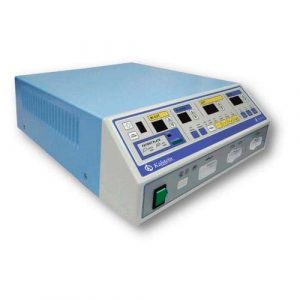An electric scalpel or scalpel is medical equipment that converts electrical energy into heat to cut or coagulate tissues and cauterize them at the same time, using currents that develop at frequencies above 200,000 Hz. This equipment uses these frequencies, because with them only heat is produced, because if you work with lower frequencies, they can interfere with the nervous processes of the body.
It is a widely used equipment in many specialties of medicine, such as cosmetic surgery, obstetrics, dentistry, orthopedics, dermatology and veterinary, because its use significantly reduces the bleeding of the tissues and causes very little thermal damage, which in turn produces a considerable time saving. Enabling effective asepsis and decreasing the likelihood of transmission of infections from diseased tissues to healthy tissues.
Complete circuit of an electroscalpel
An electroscalpel circulates high-frequency current with moderate or high intensity between two electrodes applied to the body. This causes heat to be generated at the applied site and the tissue to be cut (electrosected) or coagulated (electrocoagulated). A complete circuit of an electroscalpel consists of:
- Electrical current generator.
- Active electrode, which concentrates energy at the point of contact.
- The patient (tissue).
- A neutral return or dispersion electrode, which allows the circuit to be closed with the generator.
Monopolar Electroscalpel
It is the most used electroscalpel because it is very effective. Only one of the electrodes, the active one, is placed inside the patient’s wound, while the return electrode is located anywhere else in the patient’s body. When this electroscalpel is used, the patient is part of the electrical circuit, through which the current passes and returns.
In monopolar electrodes, the radiofrequency current flows from the generator through the active electrode, into the target tissue, through the patient, the dispersive electrode and then back into the unit. The most common injury site is where the patient’s return electrode is placed. It is a recommended technique for simpler surgical procedures when taking proper caution, and while working near critical organs.
Bipolar Electroscalpel
The bipolar electrobisturs have a lower power density than the monopolar ones, and this causes that they cannot produce cuts in the tissue (except some exceptions). It is common to use them in endoscopic applications or to seal blood vessels. In the bipolar electroscalpel, two electrodes of equal size, are joined in the instrument, this generates that the dispersion of the current is unnecessary, so neither is the patient return electrode used. The active and return electrodes are located at the site of surgery, usually within the tip of the instrument.
Most of these electrobisturs employ a lower voltage waveform to achieve coagulation and prevent collateral tissue damage. Among its benefits is that it has a lower amount of thermal dispersion, have a shorter dissection time, provide better seal quality, less blood loss, fewer conversion rates and are more cost-effective than monopolar electrosurgery.
What does Kalstein offer you?
Kalstein is a company MANUFACTURER of medical and laboratory equipment of the highest quality and the best technology at the best PRICES in the market, so you can make your PURCHASE with us, knowing that you have the service and advice of a company specialized in the field and committed to provide you with safe, economical and effective options for the performance of your functions in the right way. This time we present our Electrosurgical Generator YR02144. The electrosurgical generator combines versatility and safety, for all general electrosurgical procedures such as cutting and coagulation in clinics, offices and emergency rooms. HERE
- The YR electrosurgical generator offers a maximum power of 400 watts.
- 7 monopolar and 3 bipolar outputs are available.
- The electrosurgical generator ensures a smooth cut through all types of tissue.
- It performs automatic recognition of the return electrode, either solid or spilled.
- It offers program memory functions and automatic current monitoring.
- The argon module is optional to improve cutting and coagulation.
- Optional adapter for laparoscopy and thoracoscopy application.
- The electrosurgical generator has an easy-to-use interface.
- It has an isolated exit, all floating.
For more information we invite you to take a look: HERE


